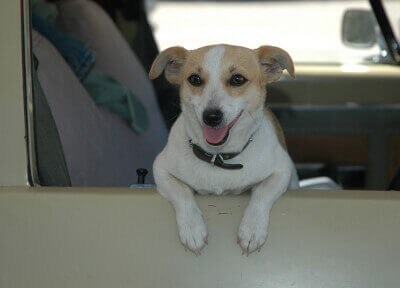How to Travel Safely With a Dog or Cat in the Car
Did you know that traveling by car with your animal companion is a lot safer than flying with them? It can be way less risky and more enjoyable for the whole family. So what are the best ways to travel with your dog or cat in the car? We’ve got you covered.
A road trip is also a great opportunity to involve your kids. You can have them help gather everything your dog or cat will need and ask them to be prepared to keep your dog occupied with lots of attention or keep your kitty calm with lots of reassurance.

How to Travel Safely With Your Dog in a Car
- Your dog should be microchipped, and your contact information should be up to date. They should also have a collar and an ID tag on at all times.
- Carry water for rest stops. No-spill travel bowls are available online and at many retailers like Target.
- For dogs prone to carsickness, consult your veterinarian for remedies or try ginger capsules, available at health-food stores.
- Dogs are safest in a transport crate or restrained with a canine seat belt, available from catalogs, pet supply stores, and online retailers such as FurHaven.
- Don’t carry your dog in a box or carrier made of cardboard—it will provide almost no protection in an accident.
- Never open a car window or door when your dog is unrestrained. Countless dogs have been lost at tollbooths and rest stops this way.
- Stop to walk dogs often.
Tips on Keeping a Cat Safe in the Car
Most cats are terrified of vehicles—including slow-moving ones. Even the horn scares them. A lot of this might be because the only time most cats see the inside of a car is when they’re headed to the veterinarian’s office. To them, cars mean that something unpleasant is about to happen. However, many cats who were introduced to car rides for fun as kittens actually seem to enjoy them. Keep in mind that this doesn’t change the fact that cats and cars are generally a bad combination.

For example, if a vehicle backfires, a dog may cower but a cat may flee. (In a strange place, chances of finding them are slim.)
Although it may be impossible for a dog of any size to squeeze through a slightly open window when a car is stopped at a gas station or rest stop, most cats can squeeze their way out of the smallest opening. And frequently, cats have become caught in the springs under the seat of a car or have had to be cut out of the metalwork over the wheelbase. Getting them out not only takes a great deal of time and effort but can also cause damage to the car. Cats may be rescued without any physical harm, but they can suffer emotionally from these events.
How to Travel Safely With Your Cat in the Car
- Make sure your cat is microchipped and that your contact information is up to date.
- Always use a sturdy carrier. Double-check that the carrier door is absolutely secure. Never let your cat loose in the car. Countless cats have been lost at tollbooths and rest stops this way.
- Create as flat an area as possible for the carrier to sit on. (Pack a towel around the outside if you need to.)
- Don’t let your kitty see that you’re headed for the car—drape a breathable cloth like a bedsheet or a light towel over the carrier before heading out the door, place the carrier on the flat space in the car, then rearrange the cloth so that your cat can see you, if possible, but not out any window. The sight of the earth or sky speeding past causes most cats to panic, begin open-mouthed breathing, and howl miserably.
- Pad the inside of the carrier with something comfy, such as a towel, to make travel easier and less bumpy.
- Play the radio softly to drown out traffic noises. (Try a soothing classical music station.)
- Talk to your cat as you go. If they complain, always answer reassuringly. This is a great time for your kids to help—have them speak softly and calmly to the cat to comfort them.
- Make the ride as smooth as possible. Avoid lurching forward, brake smoothly, and imagine that you’re delivering crystal glassware that will shatter if you don’t look ahead and steer clear of bumps and potholes in the road.
- When you arrive at your destination, let your kitty scope out the new indoor setting from the safety of the carrier. Then offer food, water, and litter outside it. In strange surroundings, ensure that all doors and windows are shut tightly before the cat emerges from the carrier.
*****
It’s important that these tips be shared with your whole family so that everyone knows what to do to help keep your animal companion safe while on a car trip. And remember NEVER to leave your animal companion in a hot car—even for just a second!





Under 13? Ask your parents bee-fore you continue!